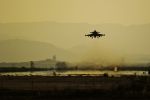JAS Gripen will satisfy the Swedish Armed Forces’ operational needs at least until 2040 and the system should constitute the core of Swedish air defences. Sweden needs at least 60–80 aircraft.
 |
| JAS 39 Gripen takes off from Sigonella Airbase as a part of Operation Unified Protector. Photographer: Johan Lundahl/Swedish Armed Forces Click to enlarge |
This is the conclusion of the Armed Forces’ analysis which is to be submitted to the Government today (Feb 29). In the work of developing alternatives, different configurations – models – of Gripen have been tested in extensive simulations and operative games – both against known and projected threat scenarios.
The capabilities enhancement of Sweden’s combat aircraft system should commence in 2020 and it is estimated that it will take ten years. A prerequisite to be able to manage its financing is that it is carried out with at least one strategic partner country. “Discussions will soon be initiated regarding costs. It would therefore be wrong to discuss openly how much we have planned that it should cost,” says Sverker Göranson, the Supreme Commander.
The upgraded JAS 39 Gripen will have a larger hull and a more powerful engine. This is to allow more weapons and more fuel, which in turn will provide greater power and endurance. The analysis also suggests a more qualified radar system and an enhanced warning and counter-measure systems.
The upgrade of JAS Gripen is necessary in order to be operationally relevant and to ensure that our air defences in the long term maintain their position relative to the outside world. In 2011 and so far this year, extensive planning work has been carried out, for instance the work associated with capabilities enhancement and the defence structure inquiry. With the results of these analyses at hand, work is now underway to put together a proposal for the Armed Forces’ long-term financial requirements; support documentation which the Armed Forces intends to report on by 2 May.
A separate paper to the Government reports on which logistical areas – in accordance with the defence structure investigation’s proposals – will be presented to Försvarets materielverk (Defence Materiel Administration – FMV). The operations affected are essentially purchasing, administrative support, supply and engineering services. In total approximately 1500 employees in the Armed Forces will be affected. The purpose of the transfer is to save money which can be used in operational activities.
The proposal submitted is a joint proposal from the Armed Forces and FMV. The Armed Forces’ support documentation shows that in this major change, as with others, there are obvious uncertainties as to when these savings will actually materialise and how large they will finally be. The transformation of the Armed Forces which is called restructuring has now been started. In essence, this means that all employees will leave their positions and their skills will be tested in terms of operational defence force requirements. Most employees will keep their jobs and will remain working where they work today, but if there are surpluses in terms of skills in any particular location, it may lead to a new placing at another location in Sweden.
From a financial point of view, the Armed Forces is in balance until 2015, provided that grant allocations are utilised and that the savings associated with the defence structure inquiry are realized. In periods when the number of assigned soldiers and sailors is being reduced, money needs to be transferred from the fund for international operations to allow for necessary exercises and manoeuvres. The planning is based therefore on SEK 300 million being transferred from the grant allocation for international operations to the grant allocation for unit activities for the years 2014 and 2015.
Source:
Swedish Armed Forces

 von
von 